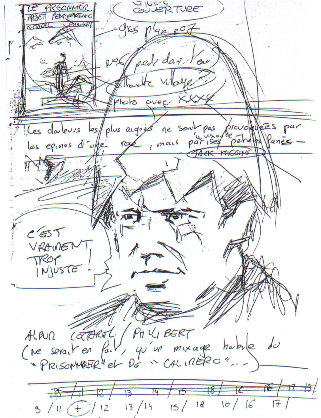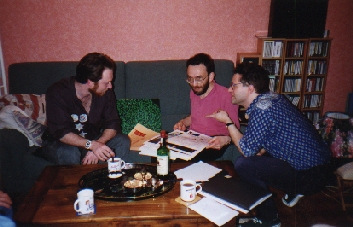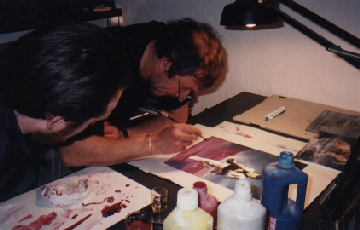
 As a matter of fact, they felt the urge, around 1990, to go beyond their previous
album which had left the bitter taste of the unachieved. Philippe Cottarel
reckons it took him 2 years to convince Jean-Michel Philibert (though he would
deny it !) to think up a new plot. The starting point, however, was agreed
right from the start: Number Six awakens in the Village suffering from amnesia.
After a year or so, a first detailed draft was produced, having undergone
extensive rewrites. From there on, the authors agreed on a 48-page format
and Jean-Michel divided up the story into as many plates, scribbling notes
on rough sketches, adding comments and providing a host of explanations, as
well as precise and, sometimes, veiled references which Philippe would later
bring to life.
As a matter of fact, they felt the urge, around 1990, to go beyond their previous
album which had left the bitter taste of the unachieved. Philippe Cottarel
reckons it took him 2 years to convince Jean-Michel Philibert (though he would
deny it !) to think up a new plot. The starting point, however, was agreed
right from the start: Number Six awakens in the Village suffering from amnesia.
After a year or so, a first detailed draft was produced, having undergone
extensive rewrites. From there on, the authors agreed on a 48-page format
and Jean-Michel divided up the story into as many plates, scribbling notes
on rough sketches, adding comments and providing a host of explanations, as
well as precise and, sometimes, veiled references which Philippe would later
bring to life.
 The
Pennyfarthing Project should be approached from several angles. First and foremost, we
are captured by the bewitching Village atmosphere and by Philippe Cottarel's fine artwork.
His talent has blossomed throughout the pages of "Le rÔdeur", the
French-language Prisoner magazine. Then we find ourselves coming back to certain pages in
order to better appreciate the layout, along with the subtleties engineered by Jean-Michel
Philibert, the skillful scriptwriter. The plot is well crafted and especially full of
references to the cinema. Spot, for instance, the nods in the direction of "The
phantom of the opera".
The
Pennyfarthing Project should be approached from several angles. First and foremost, we
are captured by the bewitching Village atmosphere and by Philippe Cottarel's fine artwork.
His talent has blossomed throughout the pages of "Le rÔdeur", the
French-language Prisoner magazine. Then we find ourselves coming back to certain pages in
order to better appreciate the layout, along with the subtleties engineered by Jean-Michel
Philibert, the skillful scriptwriter. The plot is well crafted and especially full of
references to the cinema. Spot, for instance, the nods in the direction of "The
phantom of the opera".
 Some very visual
symbols also pop up quite unexpectedly. On page 47, the target-like circle refers to the
Medicine wheel, an Indian symbol representing Man's physical and spiritual balance. On
page 45, the round shape evokes the Triskell, the Celtic symbol for the movement of
energy. On a more trivial level, Jacques Thébault, Patrick McGoohan's French voice, puts
in an appearance. The authors also couldn't resist inserting personal references like the
faces of a few close acquaintances dressed as Villagers, or the reproduction of a friend's
painting.
Some very visual
symbols also pop up quite unexpectedly. On page 47, the target-like circle refers to the
Medicine wheel, an Indian symbol representing Man's physical and spiritual balance. On
page 45, the round shape evokes the Triskell, the Celtic symbol for the movement of
energy. On a more trivial level, Jacques Thébault, Patrick McGoohan's French voice, puts
in an appearance. The authors also couldn't resist inserting personal references like the
faces of a few close acquaintances dressed as Villagers, or the reproduction of a friend's
painting.
 The two years
that it took to complete the album caused a number of reorientations. There have been
periods of intense, daily discussions by phone. As Philippe was based in Normandy
(North-West of France) at the time and Jean-Michel, a school teacher, lived in the centre
of the country, it's easy to imagine that their phonebills were sky high ! There have also
been slacker periods, which gave Jean-Michel enough time to ponder over 4 or 5 different
endings, and to check every comma, every dot of his text. Some plates had to be redrawn
three times. At first, the album was to be produced in colour. Arto Djizmedjian set out to
complete this tiresome task at the rate of 6 to 7 hours per plate.
The two years
that it took to complete the album caused a number of reorientations. There have been
periods of intense, daily discussions by phone. As Philippe was based in Normandy
(North-West of France) at the time and Jean-Michel, a school teacher, lived in the centre
of the country, it's easy to imagine that their phonebills were sky high ! There have also
been slacker periods, which gave Jean-Michel enough time to ponder over 4 or 5 different
endings, and to check every comma, every dot of his text. Some plates had to be redrawn
three times. At first, the album was to be produced in colour. Arto Djizmedjian set out to
complete this tiresome task at the rate of 6 to 7 hours per plate.

 At the same time, around 1992, the authors started visiting some of the major
French publishers to try and find an outlet for their project. In the dozen
or so that they approached, only one gave a negative feedback. Otherwise,
the album was well perceived. What actually prevented a possible release was
the fact that The Prisoner was not seen as a viable commercial product, as
opposed to say Star Wars or Star Trek .... even if DC Comics did publish a
series of four Prisoner-related comic books a few years earlier in the States.
At the same time, around 1992, the authors started visiting some of the major
French publishers to try and find an outlet for their project. In the dozen
or so that they approached, only one gave a negative feedback. Otherwise,
the album was well perceived. What actually prevented a possible release was
the fact that The Prisoner was not seen as a viable commercial product, as
opposed to say Star Wars or Star Trek .... even if DC Comics did publish a
series of four Prisoner-related comic books a few years earlier in the States.
 So the colouring
had to be dropped after about a third had been completed much to the team's chagrin. As it
became more apparent that no large-scale distribution of The Pennyfarthing Project could
be envisaged, Le rÔdeur offered to arrange for its production and promotion within the
boundaries of the French Prisoner Society, which the duo gladly accepted.
So the colouring
had to be dropped after about a third had been completed much to the team's chagrin. As it
became more apparent that no large-scale distribution of The Pennyfarthing Project could
be envisaged, Le rÔdeur offered to arrange for its production and promotion within the
boundaries of the French Prisoner Society, which the duo gladly accepted.
 A subscription
was launched for the benefit of the magazine's readers and proved a success, according to
the current standards of the French zine scene. A preview of the album was organised
during the first convention of cult series fan-clubs which took place in a famous
discotheque in Paris, in December 1996. At this stage, the cover of the album still had to
be created. This is where Christian Brantonne came in. Christian, an art teacher from
Cherbourg, had had a close, working relationship with them and provided a wealth of advice
ever since the project started. In spite of his fear and loathing of driving, he took his
car one Friday in February 1997 all the way to Philippe's house, who by then had moved to
the south of Paris where he now worked as a shop manager.
A subscription
was launched for the benefit of the magazine's readers and proved a success, according to
the current standards of the French zine scene. A preview of the album was organised
during the first convention of cult series fan-clubs which took place in a famous
discotheque in Paris, in December 1996. At this stage, the cover of the album still had to
be created. This is where Christian Brantonne came in. Christian, an art teacher from
Cherbourg, had had a close, working relationship with them and provided a wealth of advice
ever since the project started. In spite of his fear and loathing of driving, he took his
car one Friday in February 1997 all the way to Philippe's house, who by then had moved to
the south of Paris where he now worked as a shop manager.
 The cover was
completed in the little hours on the Saturday morning. Then, Philippe took his own car
down to Lyon on the same day, where the first version of the French album was to be sent
to the repro house.
The cover was
completed in the little hours on the Saturday morning. Then, Philippe took his own car
down to Lyon on the same day, where the first version of the French album was to be sent
to the repro house.
 Encouraged by the
very positive response from some of the die-hard French fans, Jean-Michel and Philippe
agreed to the idea that an English-language version should be made. This would be, we
thought, a good opportunity to broaden the album's readership as the Anglo-saxon fans form
the core of Six Of One and as, unfortunately, French no longer is the "lingua
franca". It would also, hopefully, help to pay tribute to several years of hard work
and dedication, after lifting the language barrier.
Encouraged by the
very positive response from some of the die-hard French fans, Jean-Michel and Philippe
agreed to the idea that an English-language version should be made. This would be, we
thought, a good opportunity to broaden the album's readership as the Anglo-saxon fans form
the core of Six Of One and as, unfortunately, French no longer is the "lingua
franca". It would also, hopefully, help to pay tribute to several years of hard work
and dedication, after lifting the language barrier.

 But in the end, what particularly stands out is the authors' skills at showing
us the weaknesses of this Prisoner, his doubts and his hopes, his anger and
his courage, as well as his dogged determination. In other words, the reader
is faced with a human being and can only be but moved by the philosophical
and poetic side to his struggle.
But in the end, what particularly stands out is the authors' skills at showing
us the weaknesses of this Prisoner, his doubts and his hopes, his anger and
his courage, as well as his dogged determination. In other words, the reader
is faced with a human being and can only be but moved by the philosophical
and poetic side to his struggle.
 I personally
recommend that this book be savoured whilst sipping a glass of Irish whiskey. Give up the
non-alcoholic vodka !
I personally
recommend that this book be savoured whilst sipping a glass of Irish whiskey. Give up the
non-alcoholic vodka !
 More information and how to
order from United Kindom.
More information and how to
order from United Kindom.
 More information and how to order
from the USA.
More information and how to order
from the USA.
![]()
